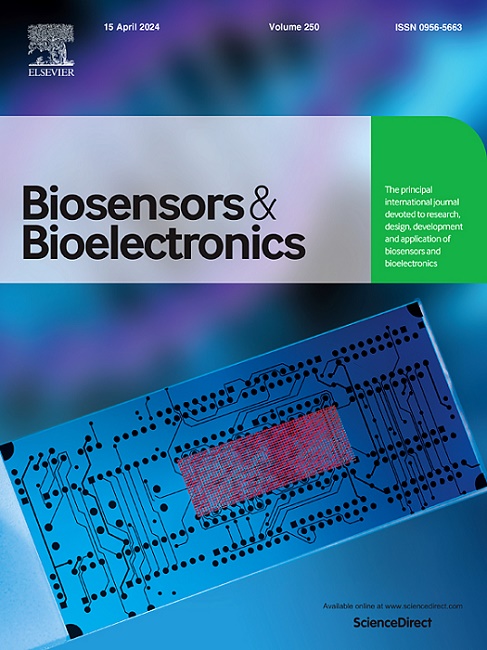Laccase-mimicking enzymes with synergistic amplification effects on catalytic activity for ergothioneine multi-pattern logic analysis
IF 10.7
1区 生物学
Q1 BIOPHYSICS
引用次数: 0
Abstract
In this work, a multimodal analysis strategy for ergothioneine (EGT) with a logical structure was constructed utilizing a novel laccase mimic enzyme (CuPH@KMO). CuPH@KMO demonstrated improved catalytic efficiency and an expanded operational pH range, attributed to synergistic interactions. Firstly, CuPH@KMO with laccase activity could not only catalyze the oxidation of the typical substrates 2,4-dichlorophenol (2,4-DP) and 4-aminoantipyrine (4-AP), but also be innovatively employed to oxidize dopamine (DA) and resorcinol (RS) to blue fluorescent azamonardine (Ex = 478 nm) with its absorbance peak located at 420 nm. Then, EGT with reducing and complexing activities could inhibit the CuPH@KMO-catalyzed oxidation of DA and RS, which resulted in the attenuation of both colorimetric and fluorescence signals. Consequently, a multimodal sensing strategy for EGT detection was developed, utilizing CuPH@KMO as the catalytic component, DA and RS as responsive substrates. This method was successfully applied to EGT analysis in cosmetics and dietary supplement. More importantly, a bimolecular logic gate with “AND” and “INHIBIT” had been successfully constructed according to the logical relationship between DA, RS and EGT, which realized the significant process of converting complex data into binary. The implementation of logic sensors based on laccase-mimicking enzymes presents novel opportunities for integrating bioanalysis with logic analysis.
具有协同扩增效应的漆酶模拟酶对麦角硫因多模式逻辑分析的催化活性
在这项工作中,利用一种新的漆酶模拟酶(CuPH@KMO)构建了具有逻辑结构的麦角硫因(EGT)的多模态分析策略。CuPH@KMO表明,由于协同作用,催化效率提高,操作pH范围扩大。首先,具有漆酶活性的CuPH@KMO不仅可以催化典型底物2,4-二氯苯酚(2,4- dp)和4-氨基安替比林(4-AP)的氧化,还可以创新地将多巴胺(DA)和间苯二酚(RS)氧化为蓝色荧光氮唑定(Ex = 478 nm),其吸光度峰位于420 nm。因此,具有还原和络合活性的EGT可以抑制DA和RS的CuPH@KMO-catalyzed氧化,从而导致比色和荧光信号的衰减。因此,开发了一种用于EGT检测的多模态传感策略,利用CuPH@KMO作为催化组分,DA和RS作为响应底物。该方法已成功应用于化妆品和膳食补充剂中EGT的分析。更重要的是,根据DA、RS和EGT之间的逻辑关系,成功构建了具有“与”和“抑制”的双分子逻辑门,实现了将复杂数据转换为二进制的重要过程。基于漆酶模拟酶的逻辑传感器的实现为整合生物分析与逻辑分析提供了新的机会。
本文章由计算机程序翻译,如有差异,请以英文原文为准。
求助全文
约1分钟内获得全文
求助全文
来源期刊

Biosensors and Bioelectronics
工程技术-电化学
CiteScore
20.80
自引率
7.10%
发文量
1006
审稿时长
29 days
期刊介绍:
Biosensors & Bioelectronics, along with its open access companion journal Biosensors & Bioelectronics: X, is the leading international publication in the field of biosensors and bioelectronics. It covers research, design, development, and application of biosensors, which are analytical devices incorporating biological materials with physicochemical transducers. These devices, including sensors, DNA chips, electronic noses, and lab-on-a-chip, produce digital signals proportional to specific analytes. Examples include immunosensors and enzyme-based biosensors, applied in various fields such as medicine, environmental monitoring, and food industry. The journal also focuses on molecular and supramolecular structures for enhancing device performance.
 求助内容:
求助内容: 应助结果提醒方式:
应助结果提醒方式:


